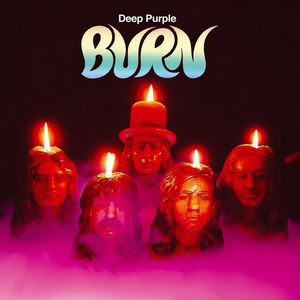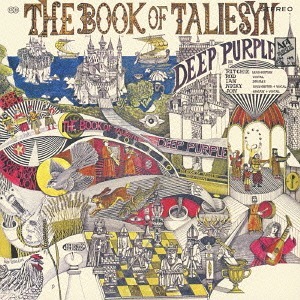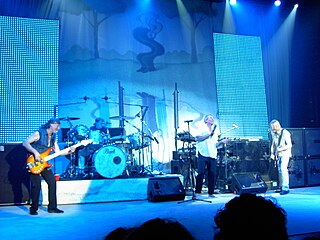
Deep Purple are an English rock band formed in London in 1968. They are considered to be among the pioneers of heavy metal and modern hard rock, but their musical approach has changed over the years. Originally formed as a psychedelic rock and progressive rock band, they shifted to a heavier sound with their 1970 album Deep Purple in Rock. Deep Purple, together with Led Zeppelin and Black Sabbath, have been referred to as the "unholy trinity of British hard rock and heavy metal in the early to mid-seventies". They were listed in the 1975 Guinness Book of World Records as "the globe's loudest band" for a 1972 concert at London's Rainbow Theatre and have sold over 100 million albums worldwide.

John Douglas Lord was an English keyboardist and composer known for his pioneering work in fusing rock with classical or baroque forms, especially with the British rock band Deep Purple. He also spent time in the bands Whitesnake, Paice Ashton Lord, The Artwoods, The Flower Pot Men and Santa Barbara Machine Head. In 1968, Lord co-founded Deep Purple, a hard rock band of which he was regarded as the leader in its early years. Together with the other members, he collaborated on most of his band's most popular songs. Lord's distinctive organ playing during Deep Purple's hard rock period was essential to the band's signature heavy sound and contributed to the early development of heavy metal. He and drummer Ian Paice were the only continuous presence in the band between 1968 and 1976, and also from when it was re-established, in 1984, until Lord's retirement in 2002. On 11 November 2010, he was inducted as an Honorary Fellow of Stevenson College in Edinburgh, Scotland. On 15 July 2011, he was awarded an honorary Doctor of Music degree at De Montfort Hall by the University of Leicester. Lord was posthumously inducted into the Rock and Roll Hall of Fame on 8 April 2016 as a member of Deep Purple.

David Coverdale is an English singer who is best known as the lead vocalist of Whitesnake, a hard rock band he founded in 1978. Before Whitesnake, Coverdale was the lead singer of Deep Purple from 1973 to 1976, after which he established his solo career. A collaboration with ex-Led Zeppelin guitarist Jimmy Page resulted in a '"Coverdale-Page'" studio album in 1993 that was subsequently certified platinum.

Stormbringer is the ninth studio album by the English rock band Deep Purple, released in November 1974 and the second studio album to feature the Mk III lineup including vocalist David Coverdale and bassist/vocalist Glenn Hughes.

Roderic Evans is a British former singer.

Made in Japan is a double live album by English rock band Deep Purple, recorded during their first tour of Japan in August 1972. It was originally released in December 1972, with a US release in April 1973, and became a commercial and critical success.

Burn is the eighth studio album by the English rock band Deep Purple, released in February 1974, and the first to feature then-unknown David Coverdale on vocals and Glenn Hughes, from Trapeze, on bass and vocals.

Shades of Deep Purple is the debut studio album by the English rock band Deep Purple, released in July 1968 on Tetragrammaton in the United States and in September 1968 on Parlophone in the United Kingdom. The band, initially called Roundabout, was the idea of former Searchers drummer Chris Curtis, who recruited Jon Lord and Ritchie Blackmore before leaving the project. The Mk. I line-up of the band was completed by vocalist/frontman Rod Evans, along with bassist Nick Simper and drummer Ian Paice, in March 1968.

The Book of Taliesyn is the second studio album by the English rock band Deep Purple, recorded only three months after Shades of Deep Purple and released by Tetragrammaton Records in October 1968, just before their first US tour. The name for the album was taken from the 14th-century Book of Taliesin.

Ian Gillan is a British singer who is best known as the lead singer and lyricist for the rock band Deep Purple. He is known for his powerful and wide-ranging singing voice.

The Rapture of the Deep tour was a worldwide concert tour by British hard rock band Deep Purple.

The following is the discography of Deep Purple, an English rock band.

"Kentucky Woman" is a 1967 song written and originally recorded by Neil Diamond.

Purple Passages is a 1972 North American, Japan and Venezuela only double-LP compilation album by Deep Purple featuring material originally released in 1968 and 1969 on the Tetragrammaton label. It features classics such as "Hush" and "Kentucky Woman". It was issued in Japan on compact disc in 1993.
The Niagara Purple Eagles men's basketball team is the college basketball team that represents Niagara University in Lewiston, New York, United States. The school's team currently competes in the Metro Atlantic Athletic Conference. The team formerly played at the now-defunct Niagara Falls Convention and Civic Center from 1973 to 1982 and from 1988 to 1996.

Deep Purple in Rock is the fourth studio album by Deep Purple, released on 5 June 1970. It was the first studio album recorded by the Mark II line-up of Ritchie Blackmore, Ian Gillan, Roger Glover, Jon Lord and Ian Paice.
"Soldier of Fortune" is a blues rock ballad written by Ritchie Blackmore and David Coverdale and originally released on Deep Purple's 1974 album Stormbringer. Although Deep Purple has never released the song as a single and it has never placed on the record charts, it has developed a cult following over the years and has been covered by many artists and bands.

Now What?! is the 19th studio album by English rock band Deep Purple. It was released on 26 April 2013 and produced by Bob Ezrin. A dedicated official web site was also created by the band to post updates about the album. It was the band's first studio album in over seven years as Deep Purple's previous studio album, Rapture of the Deep, was released in late 2005.

Matthias Laurenz Gräff is an Austrian academic painter, private historian, politician, political activist and organizer of the non-partisan platform Dialog im Kamptal from Gars am Kamp.

















